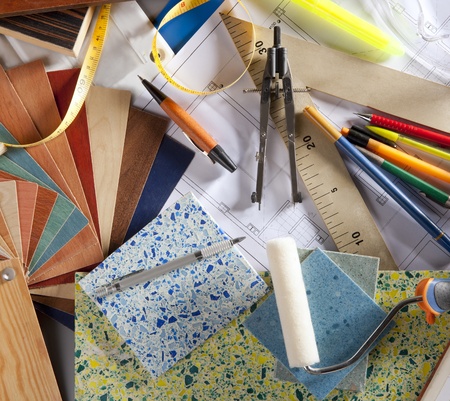1. Understanding the Difference Between Warm and Cool Colors
When designing your home interior, one of the most powerful tools you can use is color. Understanding how warm and cool colors affect the mood and feel of a space can help you create rooms that feel inviting, relaxing, or energizing—depending on what you’re going for.
What Are Warm and Cool Colors?
In color theory, colors are divided into two main groups: warm and cool. Warm colors include shades like red, orange, and yellow. These tones tend to make a room feel cozier and more intimate. Cool colors, such as blue, green, and purple, usually make a space feel calmer and more spacious.
Emotional and Psychological Effects
Each group of colors brings out different emotional responses. Heres a simple breakdown:
| Color Type | Common Colors | Emotional Effect | Best Used In |
|---|---|---|---|
| Warm Colors | Red, Orange, Yellow | Energizing, Cozy, Inviting | Living rooms, Dining rooms, Kitchens |
| Cool Colors | Blue, Green, Purple | Calming, Relaxing, Refreshing | Bedrooms, Bathrooms, Offices |
The Role of Lighting
Lighting plays a huge role in how we perceive color. Natural daylight shows the truest color. Incandescent lighting brings out warm tones and can make warm colors feel even cozier. Fluorescent lighting tends to enhance cool tones and can give spaces a cleaner look when paired with blues or greens.
Quick Tip:
If youre unsure which direction to go with your color palette, think about how you want to feel in the space. Want an energetic kitchen? Go warm. Looking for a peaceful retreat in your bedroom? Cool tones are your best friend.
This basic understanding of warm vs. cool colors sets the foundation for making smart design choices throughout your home.
2. Choosing the Right Color Temperature for Each Room
When designing your home’s interior, understanding how to match warm and cool colors with the function of each room can make a big difference. The key is to think about the mood you want to create in each space. Warm colors like red, orange, and yellow tend to feel energizing and cozy, while cool colors like blue, green, and purple evoke calmness and relaxation.
Understanding Color Temperatures
Warm Colors: These include shades like terracotta, mustard yellow, burnt orange, and coral. They work well in spaces where you want to encourage conversation or create a welcoming atmosphere.
Cool Colors: Think of soft blues, seafoam greens, and lavender. These tones help promote rest and focus, making them perfect for quieter areas of the home.
Best Color Choices by Room
The table below offers a quick guide to selecting warm or cool tones based on the room’s primary use and desired mood:
| Room | Recommended Color Temperature | Mood You Want to Create | Example Colors |
|---|---|---|---|
| Living Room | Warm | Inviting, Social | Sandy beige, Soft orange, Warm taupe |
| Dining Room | Warm | Energizing, Engaging | Cinnamon red, Golden yellow, Rustic terracotta |
| Kitchen | A mix of warm and cool | Lively yet clean | Sage green (cool), Creamy white (warm) |
| Bedroom | Cool | Calming, Restful | Pale blue, Lavender gray, Soft teal |
| Bathroom | Cool | Crisp, Refreshing | Aqua blue, Light mint green, Slate gray |
| Home Office | Cool or Neutral | Focused, Clear-headed | Dove gray (neutral), Steel blue (cool) |
Tips for Using Color Effectively
- If youre not ready to commit to painting an entire room a bold color, try incorporating warm or cool tones through accessories like throw pillows, rugs, or curtains.
- You can balance out very strong warm or cool colors with neutral shades like beige, gray, or white.
- Northern-facing rooms often benefit from warmer tones to counteract cooler natural light. Southern-facing rooms can handle cooler shades well since they get more direct sunlight.
The Role of Lighting
The type of lighting in a room also affects how colors appear. Incandescent bulbs tend to enhance warm colors, while LED lights often bring out cooler tones. Always test paint samples under your rooms actual lighting conditions before making a final decision.

3. Balancing Warm and Cool Colors in a Single Space
Creating harmony between warm and cool colors in the same room can feel tricky, but with a few thoughtful strategies, you can design a space that feels cohesive and inviting. Whether youre decorating an open-concept living area or a shared space like a living-dining combo, blending color temperatures effectively is all about balance and intention.
Use Neutral Tones as a Bridge
Neutral colors like white, beige, gray, and taupe help smooth the transition between warm and cool hues. These shades act as visual buffers, allowing bolder colors to coexist without clashing. For instance, pairing a warm terracotta wall with cool blue furniture can work well when grounded by neutral flooring or a soft gray area rug.
Layer with Textiles and Accessories
Incorporate throw pillows, blankets, curtains, or rugs in both warm and cool tones to layer the space with personality while keeping it balanced. These elements are easy to switch out seasonally or if your style changes over time.
Examples of Layering Warm and Cool Colors:
| Warm Element | Cool Element | Neutral Connector |
|---|---|---|
| Rust-colored sofa | Navy blue armchair | Cream wool rug |
| Golden yellow throw pillows | Sage green curtains | Light gray wall paint |
| Burnt orange artwork | Teal vases | Natural wood coffee table |
Create Visual Zones with Color Temperature
If youre working with an open-concept layout, consider using warm colors in one zone (like the dining area) and cool tones in another (like the living room). This subtle division helps define spaces without needing walls. Just be sure to use consistent neutrals throughout to tie everything together.
Balance Through Repetition
To keep the room feeling unified, repeat key colors across different areas. For example, if you use a warm mustard yellow in one corner, echo it somewhere else—maybe in artwork or textiles. Similarly, carry cool blues across multiple elements to avoid isolated color pops that feel disconnected.
Quick Tips for Mixing Warm and Cool Colors:
- Stick to a ratio: Use one temperature as dominant (about 70%) and the other as accent (30%).
- Add texture: Wood, metal, stone, and fabric can soften contrasts between color temps.
- Edit thoughtfully: Too many competing tones can overwhelm—keep it simple where possible.
The key is to experiment and trust your eye. With practice and small adjustments, you can find the perfect mix of warmth and coolness that reflects your personal style while creating a comfortable flow throughout your home.
4. Incorporating Color Through Paint, Furnishings, and Decor
When designing your home interior with warm and cool colors, it’s important to think beyond just wall paint. While walls are a great starting point, layering these hues through furniture, textiles, and decorative pieces creates a more cohesive and inviting space. Here’s how to effectively use color in different elements of your home.
Paint: The Foundation of Your Color Palette
Wall color sets the tone for any room. Warm colors like soft terracotta or creamy beige can make a space feel cozy and intimate, while cool tones such as pale blue or light gray add a sense of calm and openness. Consider using warm tones in areas meant for socializing like the living room or dining area, and cool colors in restful spaces like bedrooms or bathrooms.
Furnishings: Balance and Contrast
Your choice of furniture plays a big role in reinforcing your color scheme. A neutral sofa can be paired with warm-toned throw pillows for a cozy touch, or you can add a statement chair in a bold cool hue to create contrast. Use this table as a quick guide:
| Element | Warm Color Examples | Cool Color Examples |
|---|---|---|
| Sofa/Chairs | Rust, camel, mustard yellow | Navy blue, emerald green, charcoal gray |
| Coffee Tables | Walnut wood, brass finishes | Glass tops, chrome accents |
| Dining Sets | Oak wood, red-toned stains | Black metal, cool-toned painted wood |
Textiles: Adding Texture and Depth
Pillows, rugs, curtains, and bedding offer an easy way to introduce both warm and cool colors without permanent commitment. For example, layering a cool gray rug under a warm leather sofa helps balance the visual temperature of the room. Try mixing materials too—cotton and linen for cooler textures; velvet or wool for warmer vibes.
Decor Accessories: The Finishing Touches
Small decor items like vases, artwork, lampshades, and picture frames are perfect for reinforcing your color story. Choose accessories that echo the main color palette of your room but vary the shade or material to create visual interest. A cool-toned painting above a warm-colored console table creates a dynamic focal point that still feels harmonious.
Quick Tips for Layering Colors:
- Repeat colors across different elements: Use the same shade in both textiles and wall art to tie the room together.
- Create contrast with purpose: Don’t be afraid to mix warm and cool colors—but do it intentionally.
- Use neutral bases: Whites, creams, grays, and blacks help balance out strong warm or cool tones.
By thoughtfully incorporating both warm and cool tones throughout your home’s furnishings and decor—not just on the walls—you can create depth, continuity, and a space that truly reflects your personal style.
5. Lightings Impact on Color Temperature
Lighting plays a major role in how we perceive colors in a room. Both natural and artificial lighting can dramatically change the appearance of warm and cool tones, making it essential to consider your light sources when designing your home interior.
Natural Light: The Sun’s Changing Influence
The direction and time of day affect the way sunlight enters a room, which in turn impacts color temperature.
How Natural Light Affects Color
| Room Direction | Lighting Characteristics | Color Effect |
|---|---|---|
| North-facing | Cool, consistent light | Cools down warm tones; enhances cool tones |
| South-facing | Warm, bright light all day | Enhances warm colors; may wash out cool tones |
| East-facing | Warm morning light, cooler afternoon | Adds warmth early; cools later in the day |
| West-facing | Cool morning light, warm evening glow | Makes warm tones pop in the afternoon; may dull cool hues earlier in the day |
Artificial Light: Choosing the Right Bulbs
The type of bulbs you use can either enhance or clash with your color palette. Understanding color temperature ratings—measured in Kelvins (K)—helps you make smart lighting choices.
Common Bulb Types and Their Effects
| Bulb Type | Color Temperature (Kelvin) | Tone Description | Suits Best With… |
|---|---|---|---|
| Incandescent | 2700K – 3000K | Warm and yellowish | Warm color schemes like beige, terracotta, or gold |
| LED (Warm White) | 2700K – 3000K | Slightly warm, energy-efficient | Cohesive with cozy, inviting spaces using warm tones |
| LED (Cool White) | 3500K – 4100K | Crisp and neutral-white tone | Pairs well with cool tones like blues, grays, and crisp whites for a modern feel |
| Daylight LED/CFL | 5000K – 6500K | Bluish-white light, mimics daylight | Icy blues, grays, or clean white palettes; great for task areas like kitchens or bathrooms |
Tips for Matching Lighting with Your Color Scheme
- If your walls are painted in warm hues like peach or tan, opt for bulbs that emit a warmer light (around 2700K–3000K).
- If youre going for a cooler palette—like pale blue or slate gray—consider using cooler white lights (4000K–5000K) to maintain that crisp feel.
- Dimmers can help balance lighting throughout the day and adapt to different moods.
- Always test paint samples under both natural daylight and your planned artificial lighting before finalizing colors.
A well-lit space brings out the best in your color palette. By understanding how different light sources affect color temperature, you can make more informed decisions that keep your interiors looking balanced and beautiful around the clock.


